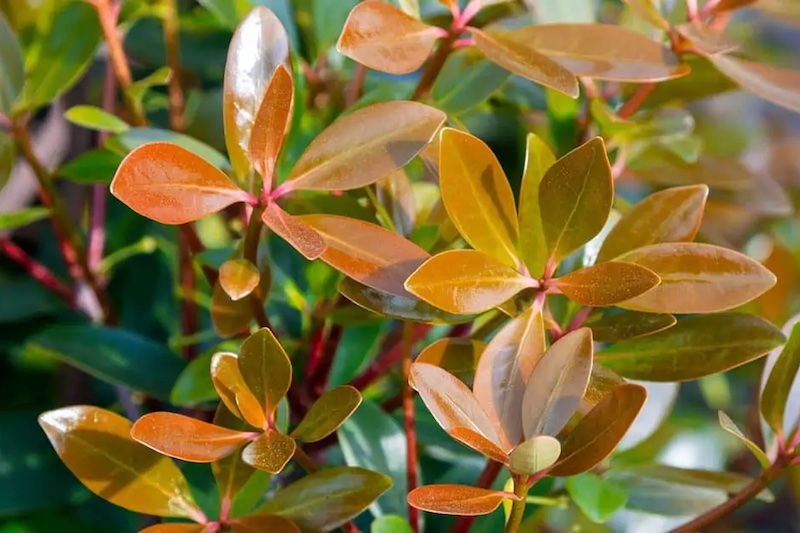Ternstroemia gymnanthera is one of the most underutilized broadleaf evergreen shrubs for USDA zones 7-10. It has gorgeous glossy leaves, often with very colorful new growth. The thick leaves stay exceptionally clean all year round and are rarely bothered by infestations of insect pests. Occasionally, waxy scale insects or southern red mite can be an issue. These pests are easily controlled either with mechanical methods or by using proven organic chemicals that are gentle on the plant and are less likely to harm beneficial insects.

Common Cleyera Pests
Waxy Scale Insects
Scale insects are sap-sucking pests that can be difficult to remove. The adults form waxy pods around themselves so that they can eat and breed safely from predators. Tiny red eggs are laid under these waxy scales in late summer and overwinter on the stems and base of leaves. In the spring, the eggs hatch and the young scale insects move to another spot on the plant to begin their feeding and breeding cycle. Sometimes the only damage is reduced growth of leaves or yellowing and eventual leaf loss. The insects tend to stay on the woody stems and in the base of leaf nodes. A secondary symptom is honeydew and black sooty mold, which occurs when the infestation is not treated. The honeydew attracts ants, which in turn harvest the honeydew as a food source. The ants will protect the scale and waxy structures against predators, making it important then to treat the plants and garden for ants.
Treating Waxy Scale Insects on Cleyera
Early infestations may be greatly reduced by scraping off the scales into a container with soapy water and throwing the insects in the trash. Pruning out branches that are heavily infested will also help to reduce the scale insects. Beneficial insects such as some types of lady beetles, parasitic wasps, and lacewings feed on scale insects. These beneficial insects are easily attracted by allowing some areas of the garden to remain more wild or naturalized, thus providing shelter and nesting for overwintering eggs and adults.
Insecticidal soap is only effective early in the spring as the temperature rises and the young scale insects hatch. The waxy scales are more likely to be broken down by the fatty acids in insecticidal soap in warm weather. Spraying affected plants in the winter will have little effect. Monterey Garden Insect Spinosad premixed spray is a dependable organic spray when used as prescribed on the manufacturer's label.
Preventing Waxy Scale Insects on Cleyera
Monitoring of plants is the best way to protect against scale insects. Acting quickly after diagnosis will help keep the outbreak small and easy to manage by non-chemical means. Good garden hygiene is always important to reduce the pest’s chances of overwintering. Shrubs grown in their preferred climate and soil conditions are less susceptible to attacks from pests and diseases. Well-draining soil and an acidic pH are two important factors that will help your Cleyera thrive in the garden.
Southern Red Mite
Southern red mites can be a nuisance on shrubs in the warmest growing zones, 8-10. These sapsucking mites are a type of spider mite. They are most active outdoors during the cooler months of spring and fall in the warm and dry climates of the South. Damage is often limited to stippling of the foliage where the mites feed. Heavy infestations can cause large amounts of foliage loss, weakening the plant and eventually causing death. Finely spun webs are sometimes present and often found between leaves and branches. If you suspect that spider mites have attacked your Cleyera, you can perform a quick test. Take a white sheet of paper and hold it under a branch where there is suspected spider mite damage. Gently shake or tap on the branch to knock any mites off. Small dark or red dots that appear to be walking around on the paper are the adult form.
Treating Southern Red Mite on Cleyera
The only time to treat southern red mites successfully is during the cooler months of spring and fall while they are active. The heat of summer forces this pest into hibernation until the return of cooler temperatures. Insecticidal soaps marked specifically to treat spider mItes should be applied according to the manufacturer's label instructions. Often treatment will need to be repeated over a series of weeks to provide good control. Safer Brand insecticidal soap is one recommended ready-to-use spray.
Preventing Southern Red Mite on Cleyera
Growing Cleyera in its preferred conditions is the best defense against an infestation of mites. Practicing good garden hygiene is also important to keeping shrubs healthy. Fallen leaves should be removed so that insects do not overwinter at the base of the shrubs. Keeping plants watered in well-draining soil will reduce the risk of southern red mites attacking. Spider mites often prefer low humidity and plants that have been stressed by too little or too much water.
Cleyera Pests Chart
|
Pest |
Identifying |
Treating |
|
Waxy Scale Insects |
Sap-sucking pests that form protective waxy pods that can cause leaf yellowing, honeydew, and sooty mold |
Scrape scales into soapy water, prune infested branches, attract beneficial insects, and use insecticidal soap or organic sprays during spring |
|
Southern Red Mite |
A type of sapsucking spider mite that looks like dark or red dots making finely spun webs between leaves and branches |
Treat during the cooler months of spring and fall using insecticidal soaps labeled for spider mites |
Sources: "Dying cleyera - Knowledgebase Question." The National Gardening Association. garden.org
 |
Author Robbin Small - Published 4-26-2023 |
